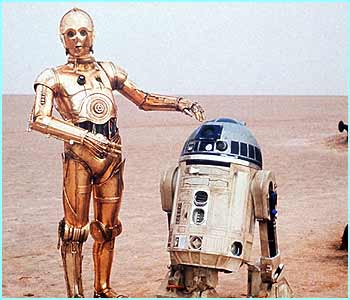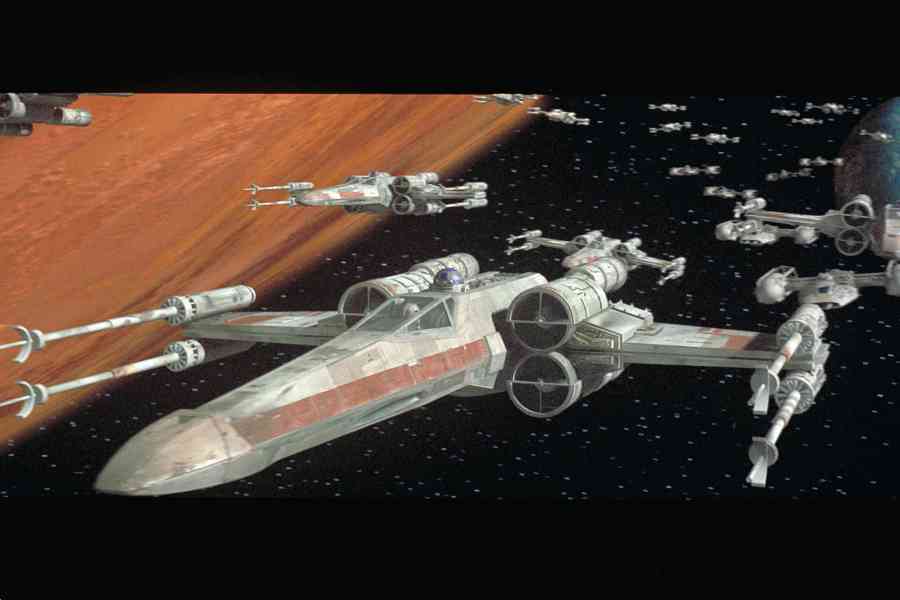A Brief History of Science Fiction Film Music
References, Links, and Works Cited
Created by Jessica Rooney
Last updated 5/1/06


Star Wars: A New Hope (1977)
Use of Sound Effects in Star Wars
While lyrical, narrative music dominates the sonic environment of Star Wars, sound effects play a crucial role in making the film believable and drawing the audience into the film. Throughout the film the sound effects are linked with technology, giving a realistic, mechanical edge to the visuals on screen. Sound effects such as the whirring of drills, the roar of spaceship engines, even the clanking of feet against the metal ramparts in the ships help to pull the audience into a world full of technology and structures that the audience knows does not exist.
Importantly, sound effects are what begin the diegetic soundtrack and the true emersion into the world of Star Wars. Immediately after the original text fades into space, the music loses its tonality and sense of purpose and the camera swings down to view the world below. In this moment the sounds of spaceships take over the music until they become the focus of the sonic atmosphere. This seems to draw the audience out of the untouchable world that the music and text inhabited, thrusting them back into a plane where sound as a consequence of seen action exists. This is why it is important for the spaceships have roaring engines even though sound in space is scientifically inaccurate because otherwise the audience would not be able to feel as if they were in the film. The sound effects bridge the gap between the world in the film and the reality of the audience, and by experiencing the sound the audience can better believe they are actually experiencing the visual action on the screen as well. Yet even though sound effects take over the opening sequence, music can still be heard in the background, performed mostly through blarring brass that seem to echo the firing of the guns and snare drum roles that give a militaristic undercurrent. In this scene and in others music is constantly in the background, intertwined with the sound effects and ready to direct emotion at any moment. This “continuity between the music and noise” (Buhler 37) seems to validate both types of sound, because both work off each other and create emotion in the audience.
While the sound effects and music do work together in the film, they also serve as separate indicators of the essential differences between the unnatural and natural. Sound effects signify the unnatural. Most obviously, sound effects highlight the technology found in the world of Star Wars, especially the “denaturalized vision of technology” (Buhler 38) as used by the Empire. In such scenes as Luke’s fight with Darth Vader on board the Imperial Star Destroyer, the sound of clanking metal and working of the ships are heightened, giving rise to tension and seeming to exist without any cause. Similarly, when the Imperial troopers are first scene as they break into the Rebel ship, the music dies away for the first time as the sound of the door being cut open with lasers is given full attention. It seems as if the music is holding its breath and the audience does likewise, instantly knowing that the producers of such sounds must be “bad.”
However, when the sound effects in Star Wars are created by Rebel troops they manage to sound natural. The most significant example of this is through the beeps and squacks of R2D2. These sound effects manage to sound nearly organic, more like an electronic version of human speech than the forced, mechanical sounds dominating the rest of the sound effects. Yet even the space vehicles of the Rebels are nearly humanoid, zipping around in space with sounds that prove to be exciting and changing rather than ominous and static.
Sound effects are also important to keep the power of the music constant. The music in the film is so strong that if it was constantly in the ears of the audience it would simply be too much and lose its effect, just as a film composed only of dialogue with no action often fails to hold audience attention. To prevent this the film has scenes without music, or only very faint musical tones background. This is especially seen in scenes that contain important dialogue, such as when Darth Vader speaks to his top general, or scenes that hang on uncertainty, as when Solo is creeping through space in an attempt to avoid the Imperial ships. In these scenes the sound effects are important in sustaining the sonic reality of the film and not leave large gaps in sound that would break the audiences belief in the world or make the reemergence of the music seem unnatural.